Privatization and Its Role in Combating Corruption: A Report
VerifiedAdded on 2023/06/05
|25
|4968
|274
Report
AI Summary
This report examines the privatization of state-owned enterprises as a strategy to combat corruption, focusing on the Australian context. It begins by defining privatization and corruption, highlighting Australia's relatively low corruption levels compared to other countries while acknowledging concerns about increasing corruption in the public sector. The report proposes privatization as a solution, supported by a research question and two hypotheses: that privatization leads to reduced corruption and economic growth, and that it improves firm efficiency. The hypotheses are explored using variables such as ownership extent, foreign direct investment, and firm profitability. A literature review supports the arguments, discussing the advantages of privatization, such as increased efficiency and technological advancements, while also acknowledging potential disadvantages like profit-driven priorities and the risk of monopolies. The report concludes by suggesting that privatization can be a useful measure to curb corruption, emphasizing the importance of ownership extent in promoting resource efficiency, employee commitment, reduced fraud, and overall profitability.
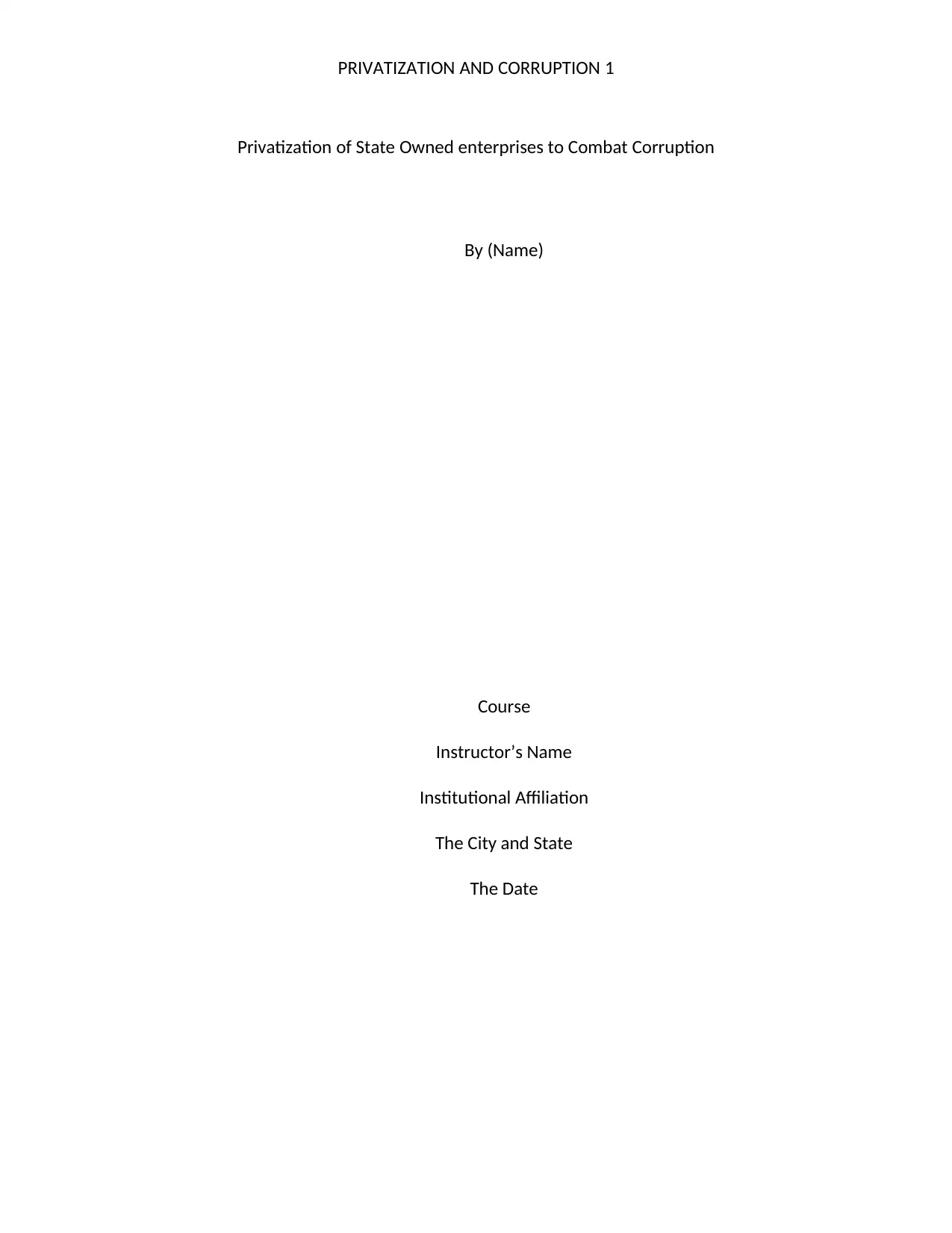
PRIVATIZATION AND CORRUPTION 1
Privatization of State Owned enterprises to Combat Corruption
By (Name)
Course
Instructor’s Name
Institutional Affiliation
The City and State
The Date
Privatization of State Owned enterprises to Combat Corruption
By (Name)
Course
Instructor’s Name
Institutional Affiliation
The City and State
The Date
Paraphrase This Document
Need a fresh take? Get an instant paraphrase of this document with our AI Paraphraser
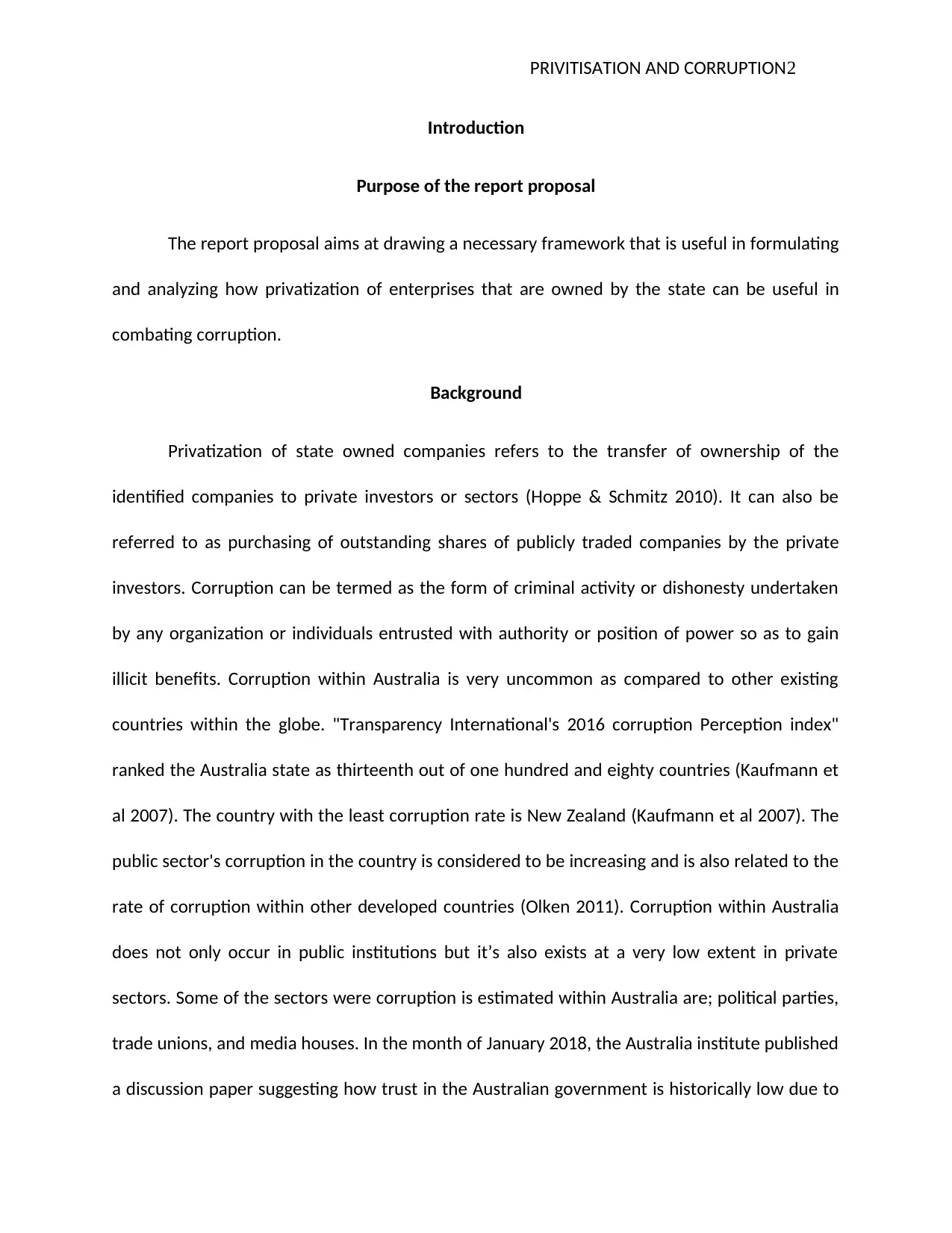
PRIVITISATION AND CORRUPTION2
Introduction
Purpose of the report proposal
The report proposal aims at drawing a necessary framework that is useful in formulating
and analyzing how privatization of enterprises that are owned by the state can be useful in
combating corruption.
Background
Privatization of state owned companies refers to the transfer of ownership of the
identified companies to private investors or sectors (Hoppe & Schmitz 2010). It can also be
referred to as purchasing of outstanding shares of publicly traded companies by the private
investors. Corruption can be termed as the form of criminal activity or dishonesty undertaken
by any organization or individuals entrusted with authority or position of power so as to gain
illicit benefits. Corruption within Australia is very uncommon as compared to other existing
countries within the globe. "Transparency International's 2016 corruption Perception index"
ranked the Australia state as thirteenth out of one hundred and eighty countries (Kaufmann et
al 2007). The country with the least corruption rate is New Zealand (Kaufmann et al 2007). The
public sector's corruption in the country is considered to be increasing and is also related to the
rate of corruption within other developed countries (Olken 2011). Corruption within Australia
does not only occur in public institutions but it’s also exists at a very low extent in private
sectors. Some of the sectors were corruption is estimated within Australia are; political parties,
trade unions, and media houses. In the month of January 2018, the Australia institute published
a discussion paper suggesting how trust in the Australian government is historically low due to
Introduction
Purpose of the report proposal
The report proposal aims at drawing a necessary framework that is useful in formulating
and analyzing how privatization of enterprises that are owned by the state can be useful in
combating corruption.
Background
Privatization of state owned companies refers to the transfer of ownership of the
identified companies to private investors or sectors (Hoppe & Schmitz 2010). It can also be
referred to as purchasing of outstanding shares of publicly traded companies by the private
investors. Corruption can be termed as the form of criminal activity or dishonesty undertaken
by any organization or individuals entrusted with authority or position of power so as to gain
illicit benefits. Corruption within Australia is very uncommon as compared to other existing
countries within the globe. "Transparency International's 2016 corruption Perception index"
ranked the Australia state as thirteenth out of one hundred and eighty countries (Kaufmann et
al 2007). The country with the least corruption rate is New Zealand (Kaufmann et al 2007). The
public sector's corruption in the country is considered to be increasing and is also related to the
rate of corruption within other developed countries (Olken 2011). Corruption within Australia
does not only occur in public institutions but it’s also exists at a very low extent in private
sectors. Some of the sectors were corruption is estimated within Australia are; political parties,
trade unions, and media houses. In the month of January 2018, the Australia institute published
a discussion paper suggesting how trust in the Australian government is historically low due to
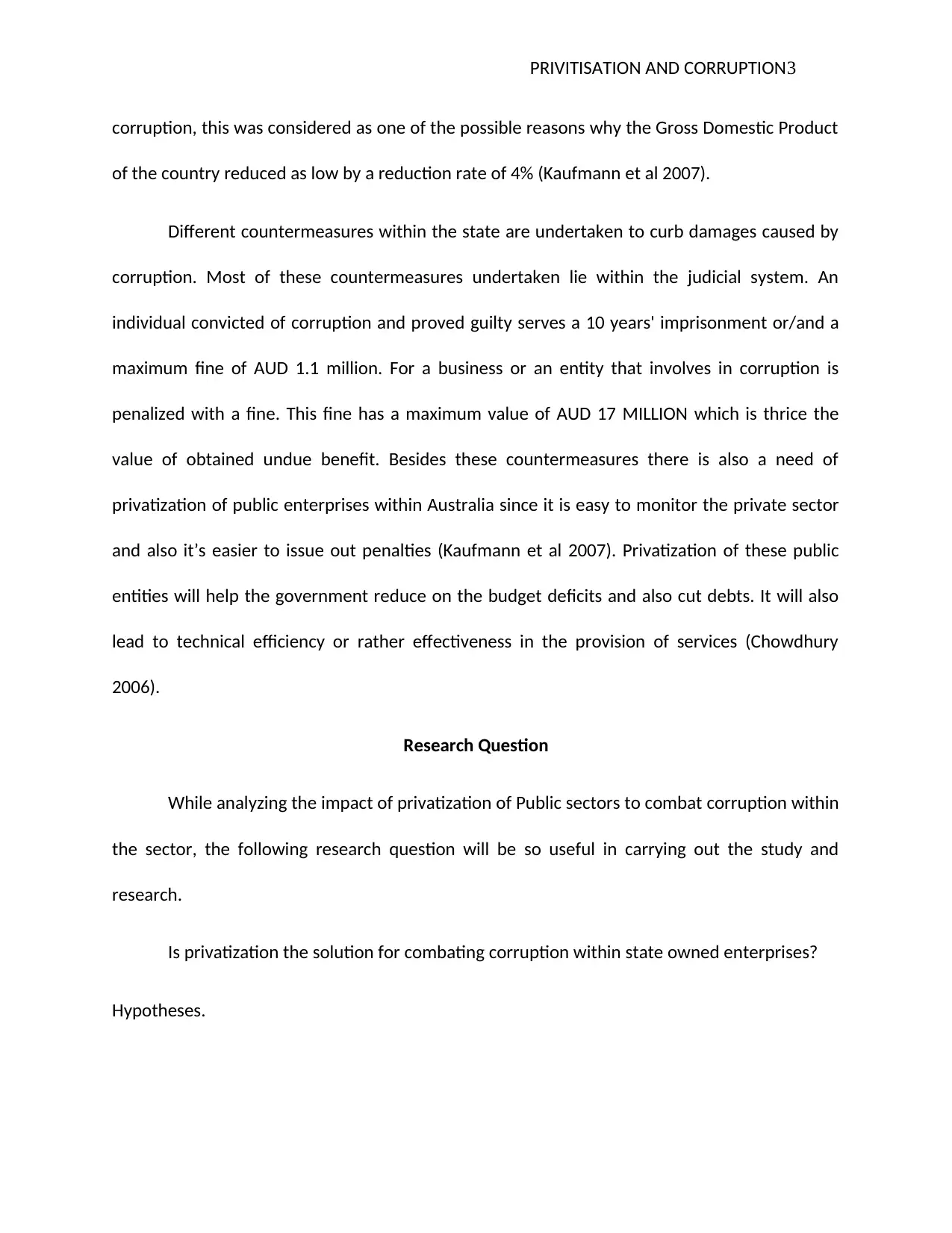
PRIVITISATION AND CORRUPTION3
corruption, this was considered as one of the possible reasons why the Gross Domestic Product
of the country reduced as low by a reduction rate of 4% (Kaufmann et al 2007).
Different countermeasures within the state are undertaken to curb damages caused by
corruption. Most of these countermeasures undertaken lie within the judicial system. An
individual convicted of corruption and proved guilty serves a 10 years' imprisonment or/and a
maximum fine of AUD 1.1 million. For a business or an entity that involves in corruption is
penalized with a fine. This fine has a maximum value of AUD 17 MILLION which is thrice the
value of obtained undue benefit. Besides these countermeasures there is also a need of
privatization of public enterprises within Australia since it is easy to monitor the private sector
and also it’s easier to issue out penalties (Kaufmann et al 2007). Privatization of these public
entities will help the government reduce on the budget deficits and also cut debts. It will also
lead to technical efficiency or rather effectiveness in the provision of services (Chowdhury
2006).
Research Question
While analyzing the impact of privatization of Public sectors to combat corruption within
the sector, the following research question will be so useful in carrying out the study and
research.
Is privatization the solution for combating corruption within state owned enterprises?
Hypotheses.
corruption, this was considered as one of the possible reasons why the Gross Domestic Product
of the country reduced as low by a reduction rate of 4% (Kaufmann et al 2007).
Different countermeasures within the state are undertaken to curb damages caused by
corruption. Most of these countermeasures undertaken lie within the judicial system. An
individual convicted of corruption and proved guilty serves a 10 years' imprisonment or/and a
maximum fine of AUD 1.1 million. For a business or an entity that involves in corruption is
penalized with a fine. This fine has a maximum value of AUD 17 MILLION which is thrice the
value of obtained undue benefit. Besides these countermeasures there is also a need of
privatization of public enterprises within Australia since it is easy to monitor the private sector
and also it’s easier to issue out penalties (Kaufmann et al 2007). Privatization of these public
entities will help the government reduce on the budget deficits and also cut debts. It will also
lead to technical efficiency or rather effectiveness in the provision of services (Chowdhury
2006).
Research Question
While analyzing the impact of privatization of Public sectors to combat corruption within
the sector, the following research question will be so useful in carrying out the study and
research.
Is privatization the solution for combating corruption within state owned enterprises?
Hypotheses.
⊘ This is a preview!⊘
Do you want full access?
Subscribe today to unlock all pages.

Trusted by 1+ million students worldwide
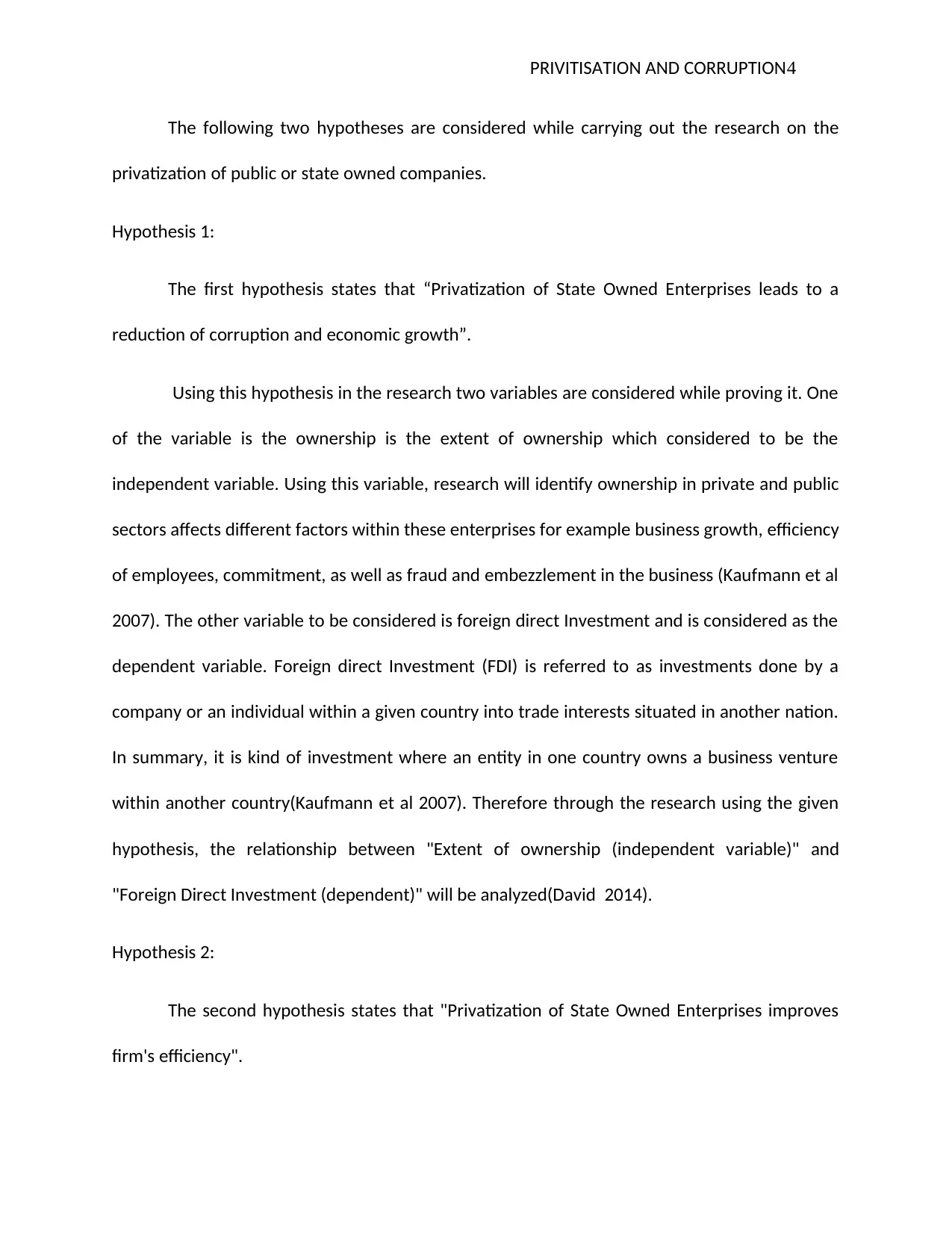
PRIVITISATION AND CORRUPTION4
The following two hypotheses are considered while carrying out the research on the
privatization of public or state owned companies.
Hypothesis 1:
The first hypothesis states that “Privatization of State Owned Enterprises leads to a
reduction of corruption and economic growth”.
Using this hypothesis in the research two variables are considered while proving it. One
of the variable is the ownership is the extent of ownership which considered to be the
independent variable. Using this variable, research will identify ownership in private and public
sectors affects different factors within these enterprises for example business growth, efficiency
of employees, commitment, as well as fraud and embezzlement in the business (Kaufmann et al
2007). The other variable to be considered is foreign direct Investment and is considered as the
dependent variable. Foreign direct Investment (FDI) is referred to as investments done by a
company or an individual within a given country into trade interests situated in another nation.
In summary, it is kind of investment where an entity in one country owns a business venture
within another country(Kaufmann et al 2007). Therefore through the research using the given
hypothesis, the relationship between "Extent of ownership (independent variable)" and
"Foreign Direct Investment (dependent)" will be analyzed(David 2014).
Hypothesis 2:
The second hypothesis states that "Privatization of State Owned Enterprises improves
firm's efficiency".
The following two hypotheses are considered while carrying out the research on the
privatization of public or state owned companies.
Hypothesis 1:
The first hypothesis states that “Privatization of State Owned Enterprises leads to a
reduction of corruption and economic growth”.
Using this hypothesis in the research two variables are considered while proving it. One
of the variable is the ownership is the extent of ownership which considered to be the
independent variable. Using this variable, research will identify ownership in private and public
sectors affects different factors within these enterprises for example business growth, efficiency
of employees, commitment, as well as fraud and embezzlement in the business (Kaufmann et al
2007). The other variable to be considered is foreign direct Investment and is considered as the
dependent variable. Foreign direct Investment (FDI) is referred to as investments done by a
company or an individual within a given country into trade interests situated in another nation.
In summary, it is kind of investment where an entity in one country owns a business venture
within another country(Kaufmann et al 2007). Therefore through the research using the given
hypothesis, the relationship between "Extent of ownership (independent variable)" and
"Foreign Direct Investment (dependent)" will be analyzed(David 2014).
Hypothesis 2:
The second hypothesis states that "Privatization of State Owned Enterprises improves
firm's efficiency".
Paraphrase This Document
Need a fresh take? Get an instant paraphrase of this document with our AI Paraphraser
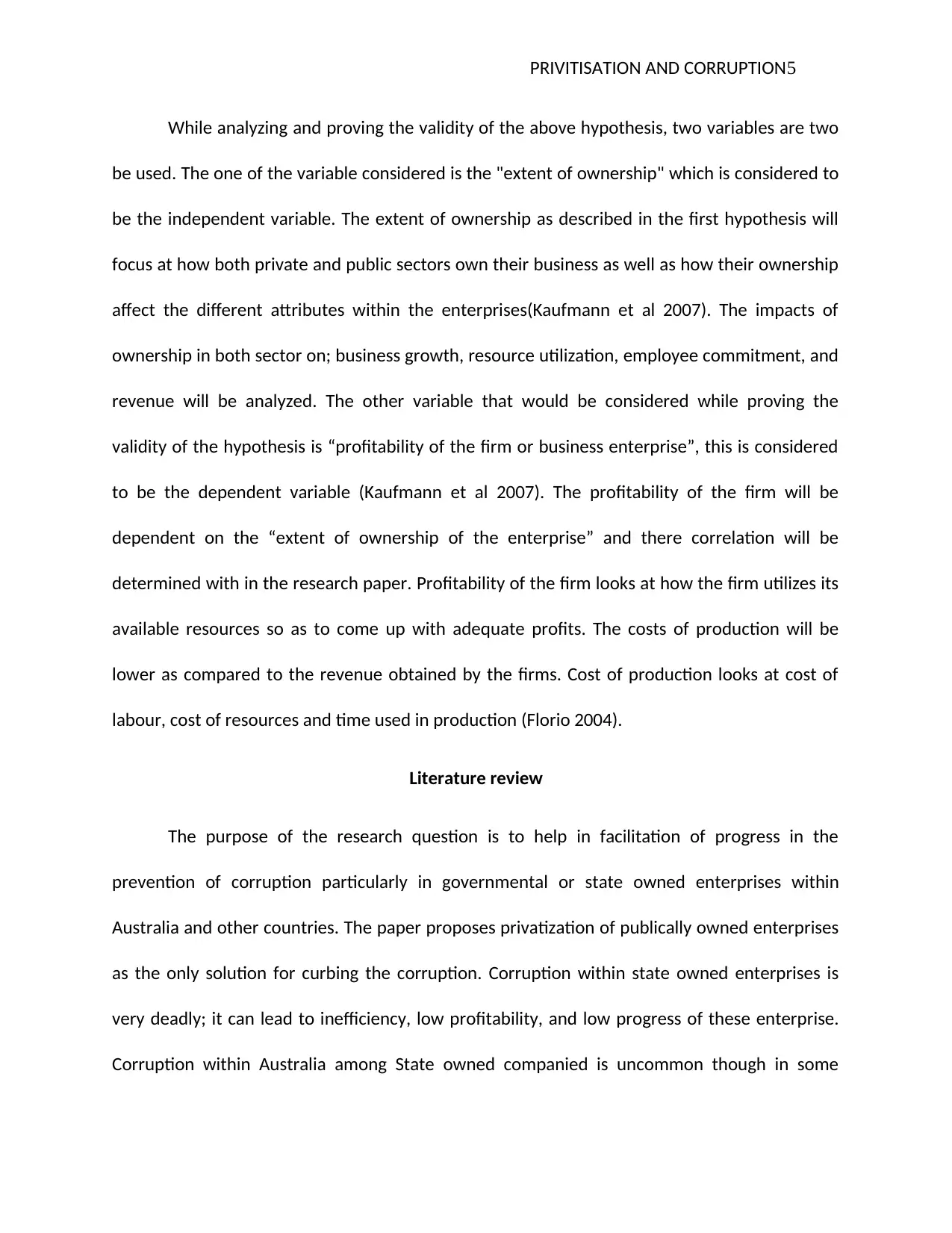
PRIVITISATION AND CORRUPTION5
While analyzing and proving the validity of the above hypothesis, two variables are two
be used. The one of the variable considered is the "extent of ownership" which is considered to
be the independent variable. The extent of ownership as described in the first hypothesis will
focus at how both private and public sectors own their business as well as how their ownership
affect the different attributes within the enterprises(Kaufmann et al 2007). The impacts of
ownership in both sector on; business growth, resource utilization, employee commitment, and
revenue will be analyzed. The other variable that would be considered while proving the
validity of the hypothesis is “profitability of the firm or business enterprise”, this is considered
to be the dependent variable (Kaufmann et al 2007). The profitability of the firm will be
dependent on the “extent of ownership of the enterprise” and there correlation will be
determined with in the research paper. Profitability of the firm looks at how the firm utilizes its
available resources so as to come up with adequate profits. The costs of production will be
lower as compared to the revenue obtained by the firms. Cost of production looks at cost of
labour, cost of resources and time used in production (Florio 2004).
Literature review
The purpose of the research question is to help in facilitation of progress in the
prevention of corruption particularly in governmental or state owned enterprises within
Australia and other countries. The paper proposes privatization of publically owned enterprises
as the only solution for curbing the corruption. Corruption within state owned enterprises is
very deadly; it can lead to inefficiency, low profitability, and low progress of these enterprise.
Corruption within Australia among State owned companied is uncommon though in some
While analyzing and proving the validity of the above hypothesis, two variables are two
be used. The one of the variable considered is the "extent of ownership" which is considered to
be the independent variable. The extent of ownership as described in the first hypothesis will
focus at how both private and public sectors own their business as well as how their ownership
affect the different attributes within the enterprises(Kaufmann et al 2007). The impacts of
ownership in both sector on; business growth, resource utilization, employee commitment, and
revenue will be analyzed. The other variable that would be considered while proving the
validity of the hypothesis is “profitability of the firm or business enterprise”, this is considered
to be the dependent variable (Kaufmann et al 2007). The profitability of the firm will be
dependent on the “extent of ownership of the enterprise” and there correlation will be
determined with in the research paper. Profitability of the firm looks at how the firm utilizes its
available resources so as to come up with adequate profits. The costs of production will be
lower as compared to the revenue obtained by the firms. Cost of production looks at cost of
labour, cost of resources and time used in production (Florio 2004).
Literature review
The purpose of the research question is to help in facilitation of progress in the
prevention of corruption particularly in governmental or state owned enterprises within
Australia and other countries. The paper proposes privatization of publically owned enterprises
as the only solution for curbing the corruption. Corruption within state owned enterprises is
very deadly; it can lead to inefficiency, low profitability, and low progress of these enterprise.
Corruption within Australia among State owned companied is uncommon though in some
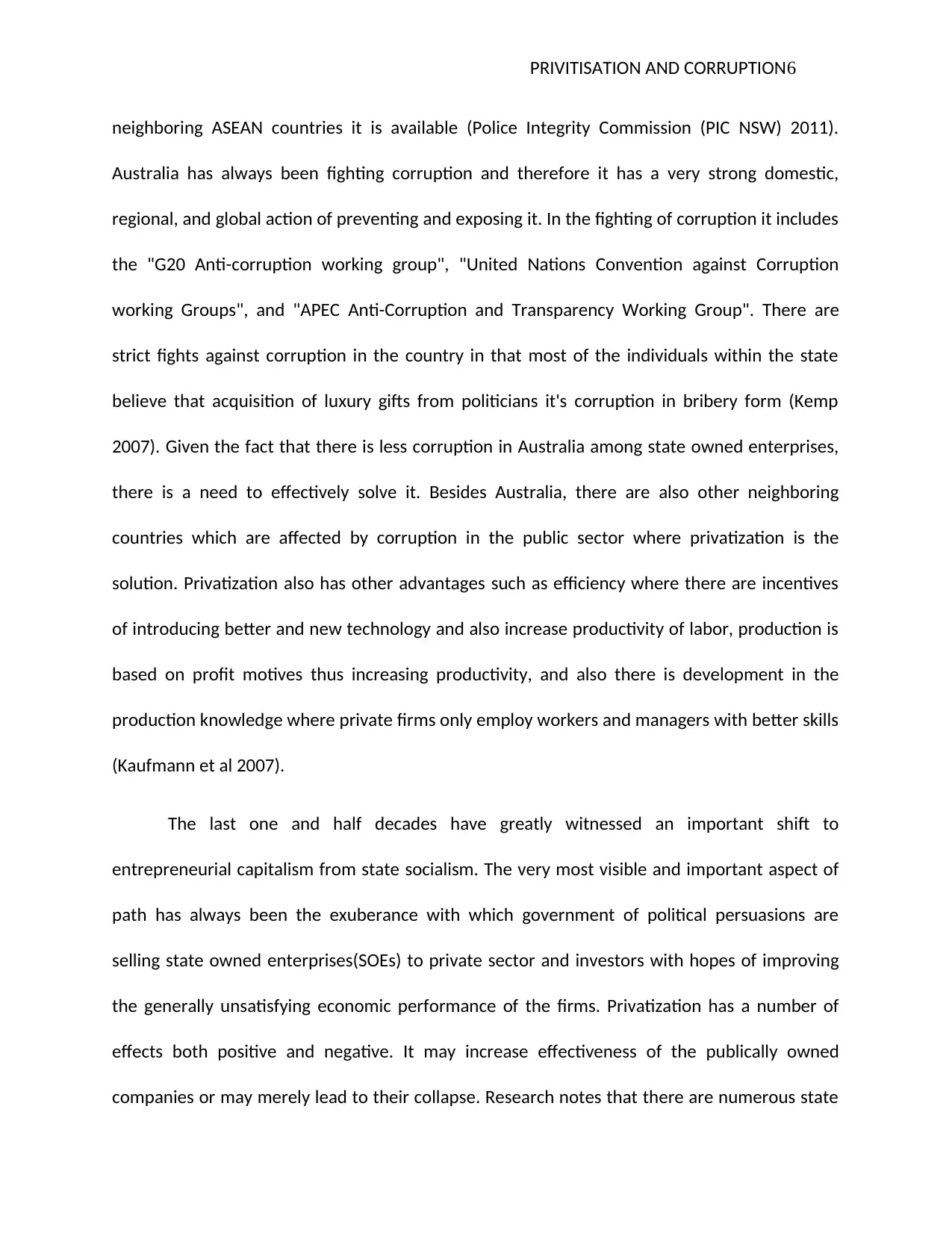
PRIVITISATION AND CORRUPTION6
neighboring ASEAN countries it is available (Police Integrity Commission (PIC NSW) 2011).
Australia has always been fighting corruption and therefore it has a very strong domestic,
regional, and global action of preventing and exposing it. In the fighting of corruption it includes
the "G20 Anti-corruption working group", "United Nations Convention against Corruption
working Groups", and "APEC Anti-Corruption and Transparency Working Group". There are
strict fights against corruption in the country in that most of the individuals within the state
believe that acquisition of luxury gifts from politicians it's corruption in bribery form (Kemp
2007). Given the fact that there is less corruption in Australia among state owned enterprises,
there is a need to effectively solve it. Besides Australia, there are also other neighboring
countries which are affected by corruption in the public sector where privatization is the
solution. Privatization also has other advantages such as efficiency where there are incentives
of introducing better and new technology and also increase productivity of labor, production is
based on profit motives thus increasing productivity, and also there is development in the
production knowledge where private firms only employ workers and managers with better skills
(Kaufmann et al 2007).
The last one and half decades have greatly witnessed an important shift to
entrepreneurial capitalism from state socialism. The very most visible and important aspect of
path has always been the exuberance with which government of political persuasions are
selling state owned enterprises(SOEs) to private sector and investors with hopes of improving
the generally unsatisfying economic performance of the firms. Privatization has a number of
effects both positive and negative. It may increase effectiveness of the publically owned
companies or may merely lead to their collapse. Research notes that there are numerous state
neighboring ASEAN countries it is available (Police Integrity Commission (PIC NSW) 2011).
Australia has always been fighting corruption and therefore it has a very strong domestic,
regional, and global action of preventing and exposing it. In the fighting of corruption it includes
the "G20 Anti-corruption working group", "United Nations Convention against Corruption
working Groups", and "APEC Anti-Corruption and Transparency Working Group". There are
strict fights against corruption in the country in that most of the individuals within the state
believe that acquisition of luxury gifts from politicians it's corruption in bribery form (Kemp
2007). Given the fact that there is less corruption in Australia among state owned enterprises,
there is a need to effectively solve it. Besides Australia, there are also other neighboring
countries which are affected by corruption in the public sector where privatization is the
solution. Privatization also has other advantages such as efficiency where there are incentives
of introducing better and new technology and also increase productivity of labor, production is
based on profit motives thus increasing productivity, and also there is development in the
production knowledge where private firms only employ workers and managers with better skills
(Kaufmann et al 2007).
The last one and half decades have greatly witnessed an important shift to
entrepreneurial capitalism from state socialism. The very most visible and important aspect of
path has always been the exuberance with which government of political persuasions are
selling state owned enterprises(SOEs) to private sector and investors with hopes of improving
the generally unsatisfying economic performance of the firms. Privatization has a number of
effects both positive and negative. It may increase effectiveness of the publically owned
companies or may merely lead to their collapse. Research notes that there are numerous state
⊘ This is a preview!⊘
Do you want full access?
Subscribe today to unlock all pages.

Trusted by 1+ million students worldwide
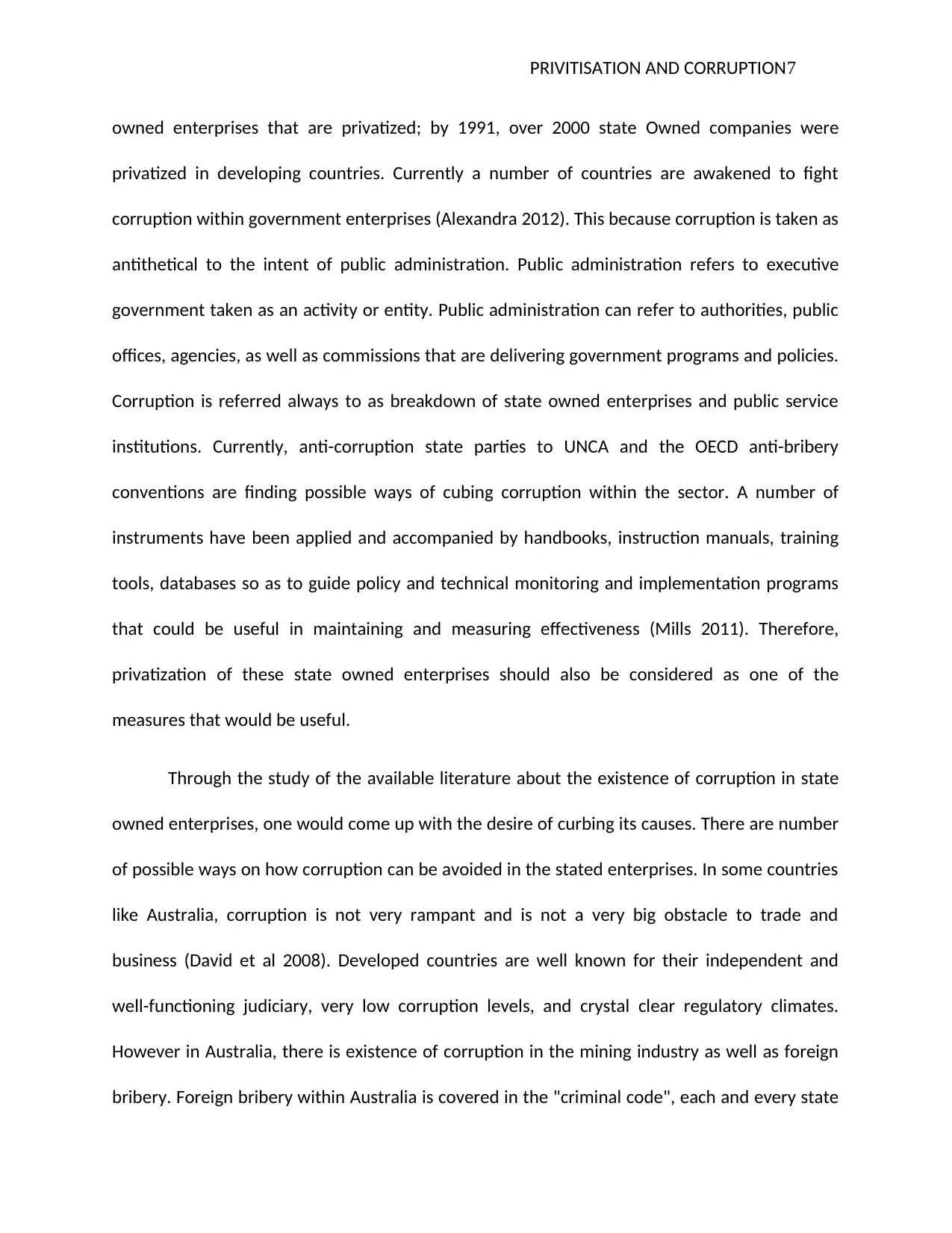
PRIVITISATION AND CORRUPTION7
owned enterprises that are privatized; by 1991, over 2000 state Owned companies were
privatized in developing countries. Currently a number of countries are awakened to fight
corruption within government enterprises (Alexandra 2012). This because corruption is taken as
antithetical to the intent of public administration. Public administration refers to executive
government taken as an activity or entity. Public administration can refer to authorities, public
offices, agencies, as well as commissions that are delivering government programs and policies.
Corruption is referred always to as breakdown of state owned enterprises and public service
institutions. Currently, anti-corruption state parties to UNCA and the OECD anti-bribery
conventions are finding possible ways of cubing corruption within the sector. A number of
instruments have been applied and accompanied by handbooks, instruction manuals, training
tools, databases so as to guide policy and technical monitoring and implementation programs
that could be useful in maintaining and measuring effectiveness (Mills 2011). Therefore,
privatization of these state owned enterprises should also be considered as one of the
measures that would be useful.
Through the study of the available literature about the existence of corruption in state
owned enterprises, one would come up with the desire of curbing its causes. There are number
of possible ways on how corruption can be avoided in the stated enterprises. In some countries
like Australia, corruption is not very rampant and is not a very big obstacle to trade and
business (David et al 2008). Developed countries are well known for their independent and
well-functioning judiciary, very low corruption levels, and crystal clear regulatory climates.
However in Australia, there is existence of corruption in the mining industry as well as foreign
bribery. Foreign bribery within Australia is covered in the "criminal code", each and every state
owned enterprises that are privatized; by 1991, over 2000 state Owned companies were
privatized in developing countries. Currently a number of countries are awakened to fight
corruption within government enterprises (Alexandra 2012). This because corruption is taken as
antithetical to the intent of public administration. Public administration refers to executive
government taken as an activity or entity. Public administration can refer to authorities, public
offices, agencies, as well as commissions that are delivering government programs and policies.
Corruption is referred always to as breakdown of state owned enterprises and public service
institutions. Currently, anti-corruption state parties to UNCA and the OECD anti-bribery
conventions are finding possible ways of cubing corruption within the sector. A number of
instruments have been applied and accompanied by handbooks, instruction manuals, training
tools, databases so as to guide policy and technical monitoring and implementation programs
that could be useful in maintaining and measuring effectiveness (Mills 2011). Therefore,
privatization of these state owned enterprises should also be considered as one of the
measures that would be useful.
Through the study of the available literature about the existence of corruption in state
owned enterprises, one would come up with the desire of curbing its causes. There are number
of possible ways on how corruption can be avoided in the stated enterprises. In some countries
like Australia, corruption is not very rampant and is not a very big obstacle to trade and
business (David et al 2008). Developed countries are well known for their independent and
well-functioning judiciary, very low corruption levels, and crystal clear regulatory climates.
However in Australia, there is existence of corruption in the mining industry as well as foreign
bribery. Foreign bribery within Australia is covered in the "criminal code", each and every state
Paraphrase This Document
Need a fresh take? Get an instant paraphrase of this document with our AI Paraphraser
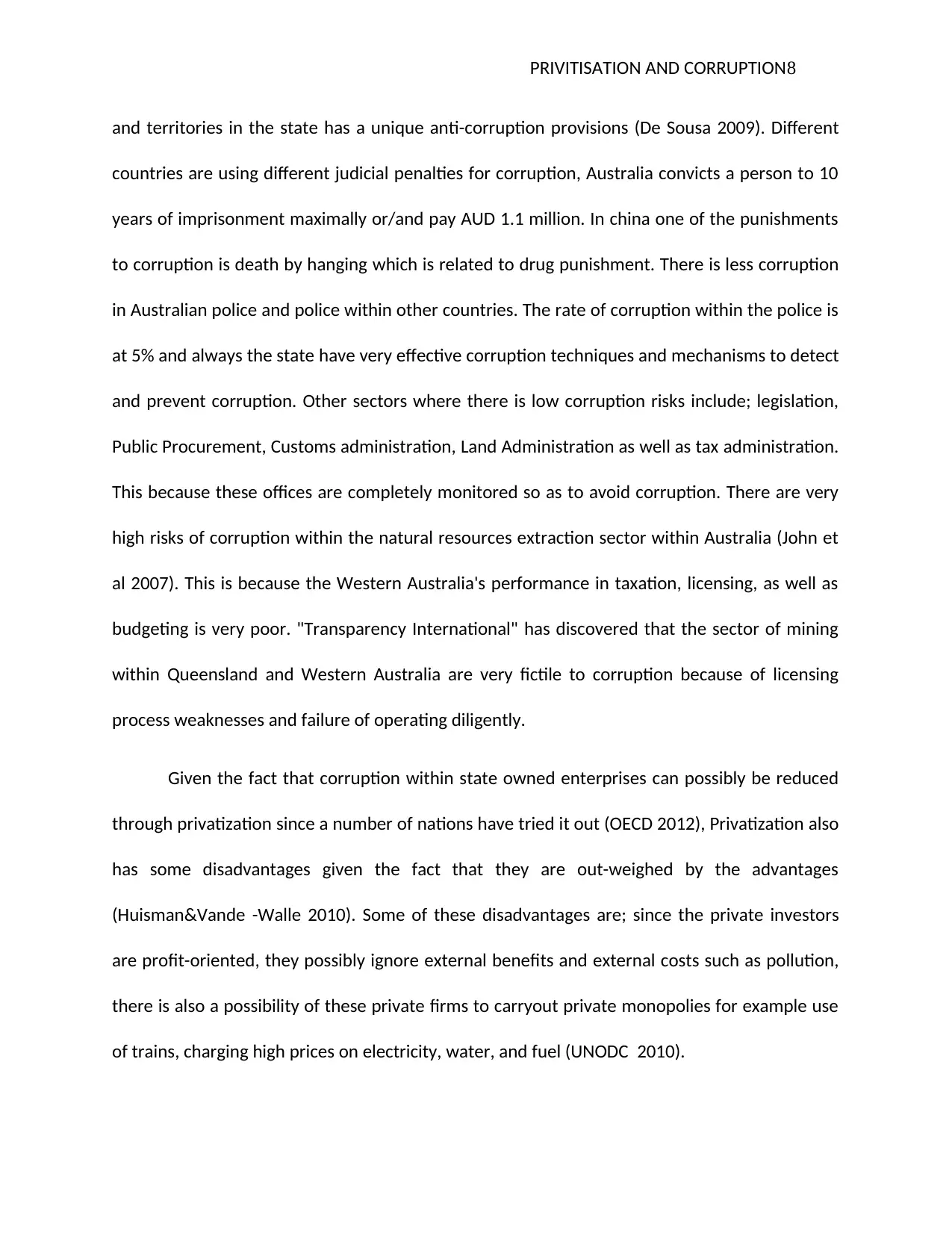
PRIVITISATION AND CORRUPTION8
and territories in the state has a unique anti-corruption provisions (De Sousa 2009). Different
countries are using different judicial penalties for corruption, Australia convicts a person to 10
years of imprisonment maximally or/and pay AUD 1.1 million. In china one of the punishments
to corruption is death by hanging which is related to drug punishment. There is less corruption
in Australian police and police within other countries. The rate of corruption within the police is
at 5% and always the state have very effective corruption techniques and mechanisms to detect
and prevent corruption. Other sectors where there is low corruption risks include; legislation,
Public Procurement, Customs administration, Land Administration as well as tax administration.
This because these offices are completely monitored so as to avoid corruption. There are very
high risks of corruption within the natural resources extraction sector within Australia (John et
al 2007). This is because the Western Australia's performance in taxation, licensing, as well as
budgeting is very poor. "Transparency International" has discovered that the sector of mining
within Queensland and Western Australia are very fictile to corruption because of licensing
process weaknesses and failure of operating diligently.
Given the fact that corruption within state owned enterprises can possibly be reduced
through privatization since a number of nations have tried it out (OECD 2012), Privatization also
has some disadvantages given the fact that they are out-weighed by the advantages
(Huisman&Vande -Walle 2010). Some of these disadvantages are; since the private investors
are profit-oriented, they possibly ignore external benefits and external costs such as pollution,
there is also a possibility of these private firms to carryout private monopolies for example use
of trains, charging high prices on electricity, water, and fuel (UNODC 2010).
and territories in the state has a unique anti-corruption provisions (De Sousa 2009). Different
countries are using different judicial penalties for corruption, Australia convicts a person to 10
years of imprisonment maximally or/and pay AUD 1.1 million. In china one of the punishments
to corruption is death by hanging which is related to drug punishment. There is less corruption
in Australian police and police within other countries. The rate of corruption within the police is
at 5% and always the state have very effective corruption techniques and mechanisms to detect
and prevent corruption. Other sectors where there is low corruption risks include; legislation,
Public Procurement, Customs administration, Land Administration as well as tax administration.
This because these offices are completely monitored so as to avoid corruption. There are very
high risks of corruption within the natural resources extraction sector within Australia (John et
al 2007). This is because the Western Australia's performance in taxation, licensing, as well as
budgeting is very poor. "Transparency International" has discovered that the sector of mining
within Queensland and Western Australia are very fictile to corruption because of licensing
process weaknesses and failure of operating diligently.
Given the fact that corruption within state owned enterprises can possibly be reduced
through privatization since a number of nations have tried it out (OECD 2012), Privatization also
has some disadvantages given the fact that they are out-weighed by the advantages
(Huisman&Vande -Walle 2010). Some of these disadvantages are; since the private investors
are profit-oriented, they possibly ignore external benefits and external costs such as pollution,
there is also a possibility of these private firms to carryout private monopolies for example use
of trains, charging high prices on electricity, water, and fuel (UNODC 2010).
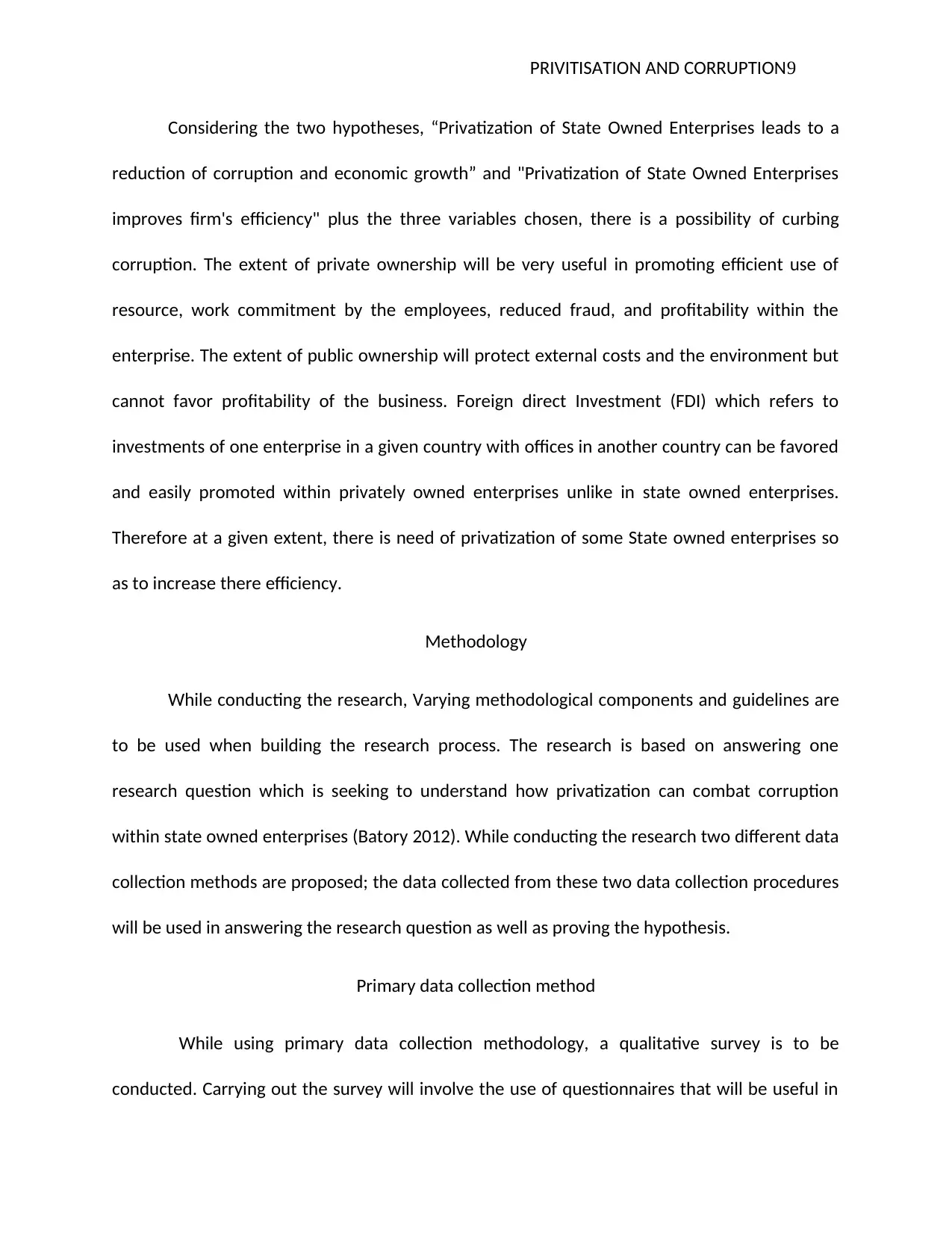
PRIVITISATION AND CORRUPTION9
Considering the two hypotheses, “Privatization of State Owned Enterprises leads to a
reduction of corruption and economic growth” and "Privatization of State Owned Enterprises
improves firm's efficiency" plus the three variables chosen, there is a possibility of curbing
corruption. The extent of private ownership will be very useful in promoting efficient use of
resource, work commitment by the employees, reduced fraud, and profitability within the
enterprise. The extent of public ownership will protect external costs and the environment but
cannot favor profitability of the business. Foreign direct Investment (FDI) which refers to
investments of one enterprise in a given country with offices in another country can be favored
and easily promoted within privately owned enterprises unlike in state owned enterprises.
Therefore at a given extent, there is need of privatization of some State owned enterprises so
as to increase there efficiency.
Methodology
While conducting the research, Varying methodological components and guidelines are
to be used when building the research process. The research is based on answering one
research question which is seeking to understand how privatization can combat corruption
within state owned enterprises (Batory 2012). While conducting the research two different data
collection methods are proposed; the data collected from these two data collection procedures
will be used in answering the research question as well as proving the hypothesis.
Primary data collection method
While using primary data collection methodology, a qualitative survey is to be
conducted. Carrying out the survey will involve the use of questionnaires that will be useful in
Considering the two hypotheses, “Privatization of State Owned Enterprises leads to a
reduction of corruption and economic growth” and "Privatization of State Owned Enterprises
improves firm's efficiency" plus the three variables chosen, there is a possibility of curbing
corruption. The extent of private ownership will be very useful in promoting efficient use of
resource, work commitment by the employees, reduced fraud, and profitability within the
enterprise. The extent of public ownership will protect external costs and the environment but
cannot favor profitability of the business. Foreign direct Investment (FDI) which refers to
investments of one enterprise in a given country with offices in another country can be favored
and easily promoted within privately owned enterprises unlike in state owned enterprises.
Therefore at a given extent, there is need of privatization of some State owned enterprises so
as to increase there efficiency.
Methodology
While conducting the research, Varying methodological components and guidelines are
to be used when building the research process. The research is based on answering one
research question which is seeking to understand how privatization can combat corruption
within state owned enterprises (Batory 2012). While conducting the research two different data
collection methods are proposed; the data collected from these two data collection procedures
will be used in answering the research question as well as proving the hypothesis.
Primary data collection method
While using primary data collection methodology, a qualitative survey is to be
conducted. Carrying out the survey will involve the use of questionnaires that will be useful in
⊘ This is a preview!⊘
Do you want full access?
Subscribe today to unlock all pages.

Trusted by 1+ million students worldwide
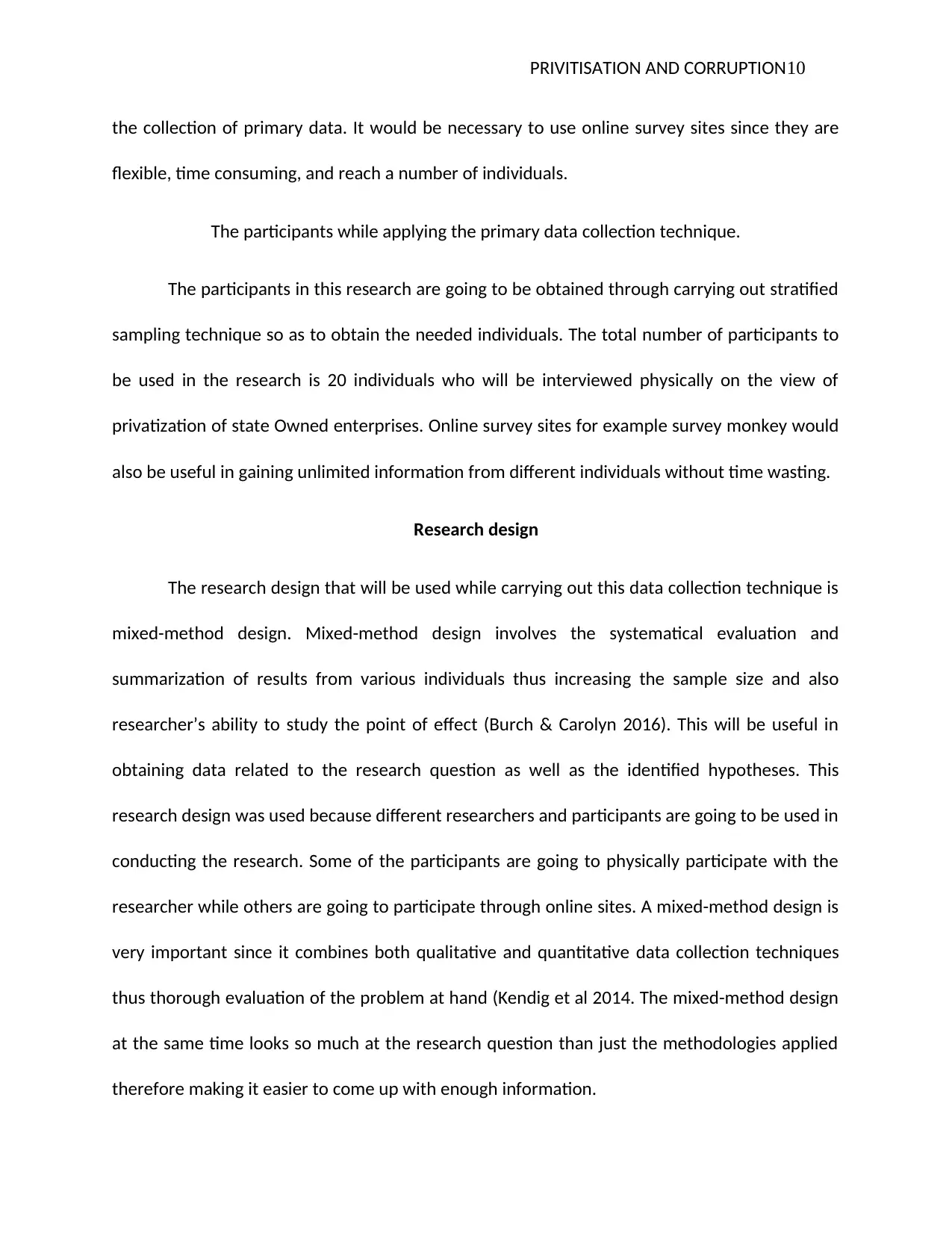
PRIVITISATION AND CORRUPTION10
the collection of primary data. It would be necessary to use online survey sites since they are
flexible, time consuming, and reach a number of individuals.
The participants while applying the primary data collection technique.
The participants in this research are going to be obtained through carrying out stratified
sampling technique so as to obtain the needed individuals. The total number of participants to
be used in the research is 20 individuals who will be interviewed physically on the view of
privatization of state Owned enterprises. Online survey sites for example survey monkey would
also be useful in gaining unlimited information from different individuals without time wasting.
Research design
The research design that will be used while carrying out this data collection technique is
mixed-method design. Mixed-method design involves the systematical evaluation and
summarization of results from various individuals thus increasing the sample size and also
researcher’s ability to study the point of effect (Burch & Carolyn 2016). This will be useful in
obtaining data related to the research question as well as the identified hypotheses. This
research design was used because different researchers and participants are going to be used in
conducting the research. Some of the participants are going to physically participate with the
researcher while others are going to participate through online sites. A mixed-method design is
very important since it combines both qualitative and quantitative data collection techniques
thus thorough evaluation of the problem at hand (Kendig et al 2014. The mixed-method design
at the same time looks so much at the research question than just the methodologies applied
therefore making it easier to come up with enough information.
the collection of primary data. It would be necessary to use online survey sites since they are
flexible, time consuming, and reach a number of individuals.
The participants while applying the primary data collection technique.
The participants in this research are going to be obtained through carrying out stratified
sampling technique so as to obtain the needed individuals. The total number of participants to
be used in the research is 20 individuals who will be interviewed physically on the view of
privatization of state Owned enterprises. Online survey sites for example survey monkey would
also be useful in gaining unlimited information from different individuals without time wasting.
Research design
The research design that will be used while carrying out this data collection technique is
mixed-method design. Mixed-method design involves the systematical evaluation and
summarization of results from various individuals thus increasing the sample size and also
researcher’s ability to study the point of effect (Burch & Carolyn 2016). This will be useful in
obtaining data related to the research question as well as the identified hypotheses. This
research design was used because different researchers and participants are going to be used in
conducting the research. Some of the participants are going to physically participate with the
researcher while others are going to participate through online sites. A mixed-method design is
very important since it combines both qualitative and quantitative data collection techniques
thus thorough evaluation of the problem at hand (Kendig et al 2014. The mixed-method design
at the same time looks so much at the research question than just the methodologies applied
therefore making it easier to come up with enough information.
Paraphrase This Document
Need a fresh take? Get an instant paraphrase of this document with our AI Paraphraser
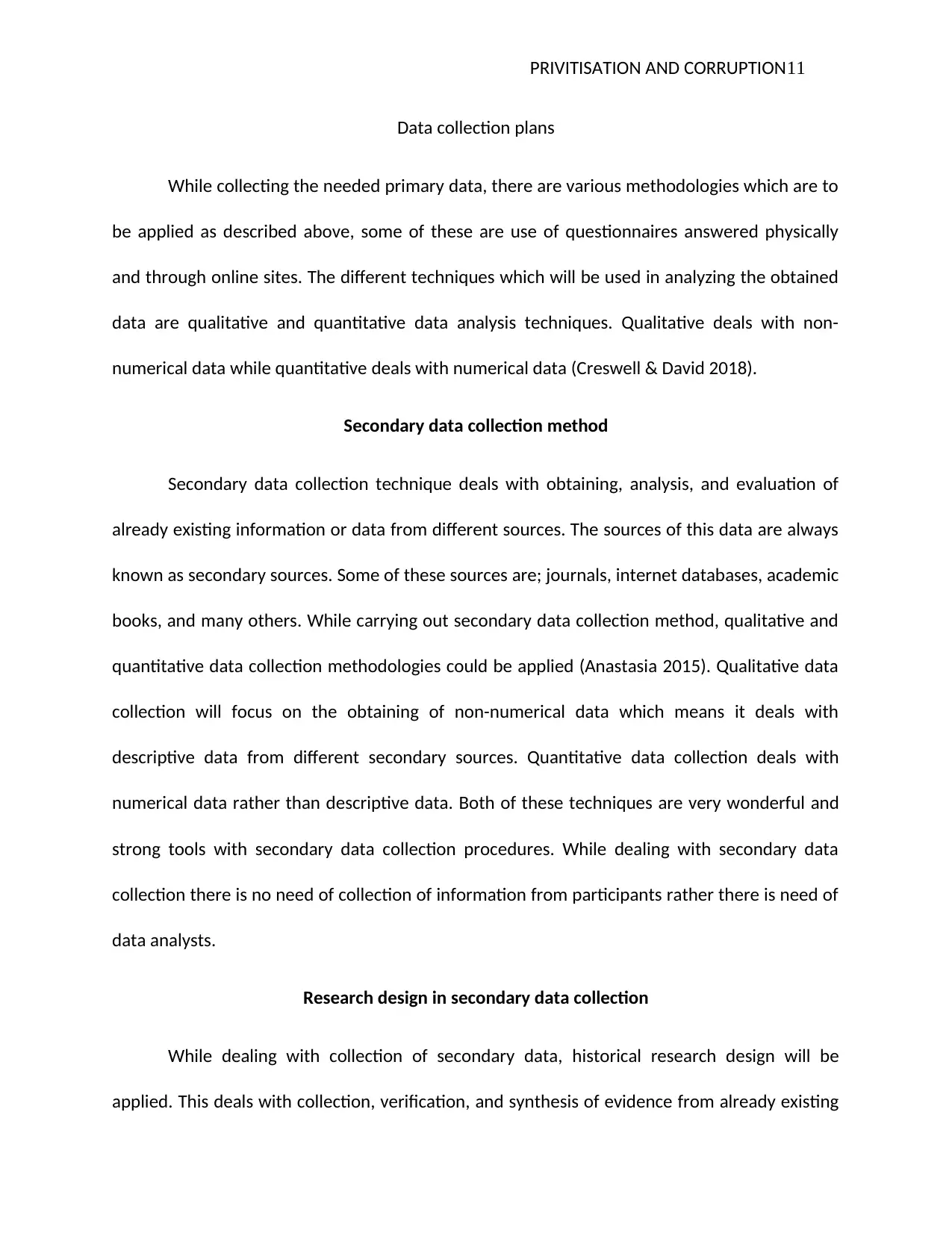
PRIVITISATION AND CORRUPTION11
Data collection plans
While collecting the needed primary data, there are various methodologies which are to
be applied as described above, some of these are use of questionnaires answered physically
and through online sites. The different techniques which will be used in analyzing the obtained
data are qualitative and quantitative data analysis techniques. Qualitative deals with non-
numerical data while quantitative deals with numerical data (Creswell & David 2018).
Secondary data collection method
Secondary data collection technique deals with obtaining, analysis, and evaluation of
already existing information or data from different sources. The sources of this data are always
known as secondary sources. Some of these sources are; journals, internet databases, academic
books, and many others. While carrying out secondary data collection method, qualitative and
quantitative data collection methodologies could be applied (Anastasia 2015). Qualitative data
collection will focus on the obtaining of non-numerical data which means it deals with
descriptive data from different secondary sources. Quantitative data collection deals with
numerical data rather than descriptive data. Both of these techniques are very wonderful and
strong tools with secondary data collection procedures. While dealing with secondary data
collection there is no need of collection of information from participants rather there is need of
data analysts.
Research design in secondary data collection
While dealing with collection of secondary data, historical research design will be
applied. This deals with collection, verification, and synthesis of evidence from already existing
Data collection plans
While collecting the needed primary data, there are various methodologies which are to
be applied as described above, some of these are use of questionnaires answered physically
and through online sites. The different techniques which will be used in analyzing the obtained
data are qualitative and quantitative data analysis techniques. Qualitative deals with non-
numerical data while quantitative deals with numerical data (Creswell & David 2018).
Secondary data collection method
Secondary data collection technique deals with obtaining, analysis, and evaluation of
already existing information or data from different sources. The sources of this data are always
known as secondary sources. Some of these sources are; journals, internet databases, academic
books, and many others. While carrying out secondary data collection method, qualitative and
quantitative data collection methodologies could be applied (Anastasia 2015). Qualitative data
collection will focus on the obtaining of non-numerical data which means it deals with
descriptive data from different secondary sources. Quantitative data collection deals with
numerical data rather than descriptive data. Both of these techniques are very wonderful and
strong tools with secondary data collection procedures. While dealing with secondary data
collection there is no need of collection of information from participants rather there is need of
data analysts.
Research design in secondary data collection
While dealing with collection of secondary data, historical research design will be
applied. This deals with collection, verification, and synthesis of evidence from already existing
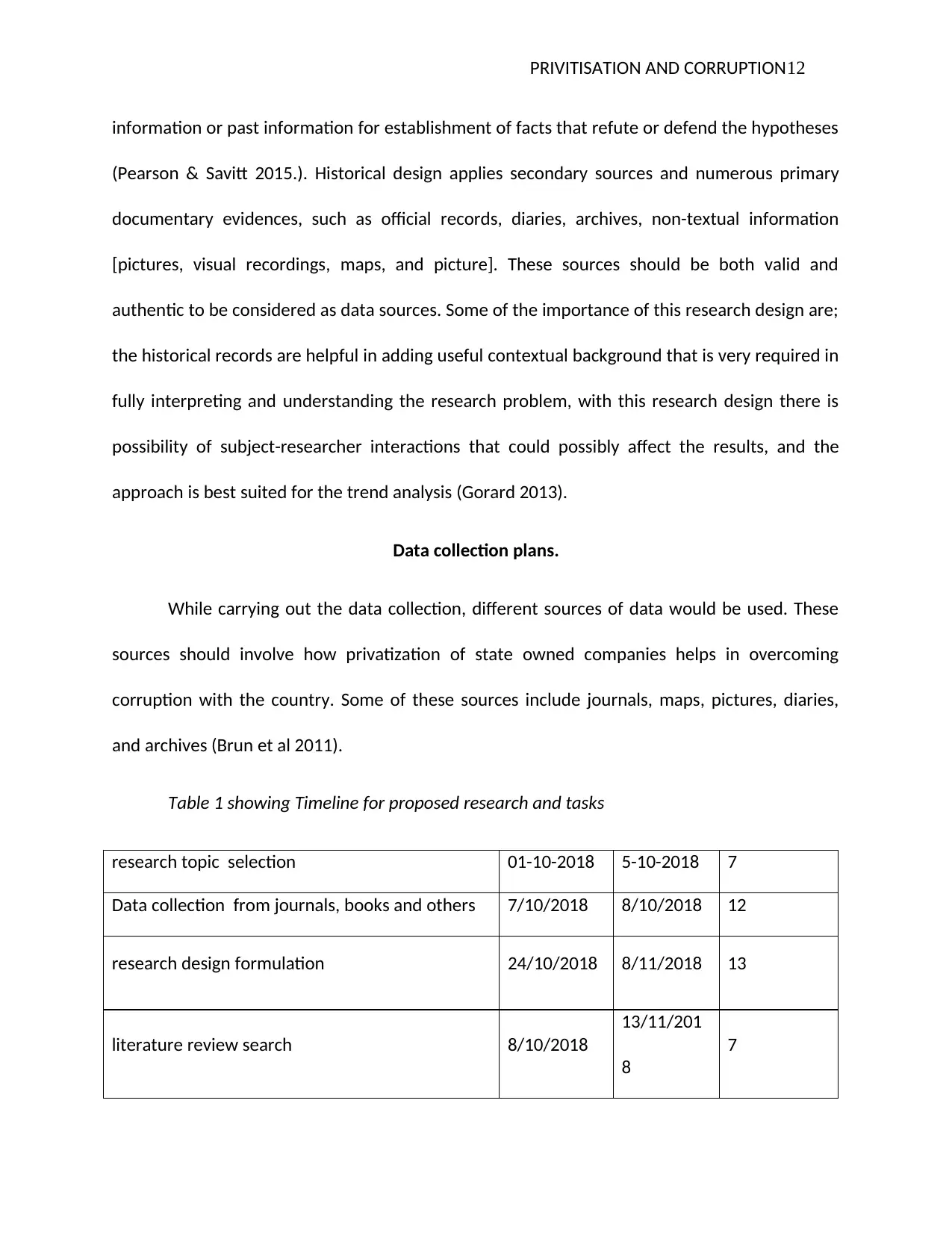
PRIVITISATION AND CORRUPTION12
information or past information for establishment of facts that refute or defend the hypotheses
(Pearson & Savitt 2015.). Historical design applies secondary sources and numerous primary
documentary evidences, such as official records, diaries, archives, non-textual information
[pictures, visual recordings, maps, and picture]. These sources should be both valid and
authentic to be considered as data sources. Some of the importance of this research design are;
the historical records are helpful in adding useful contextual background that is very required in
fully interpreting and understanding the research problem, with this research design there is
possibility of subject-researcher interactions that could possibly affect the results, and the
approach is best suited for the trend analysis (Gorard 2013).
Data collection plans.
While carrying out the data collection, different sources of data would be used. These
sources should involve how privatization of state owned companies helps in overcoming
corruption with the country. Some of these sources include journals, maps, pictures, diaries,
and archives (Brun et al 2011).
Table 1 showing Timeline for proposed research and tasks
research topic selection 01-10-2018 5-10-2018 7
Data collection from journals, books and others 7/10/2018 8/10/2018 12
research design formulation 24/10/2018 8/11/2018 13
literature review search 8/10/2018
13/11/201
8
7
information or past information for establishment of facts that refute or defend the hypotheses
(Pearson & Savitt 2015.). Historical design applies secondary sources and numerous primary
documentary evidences, such as official records, diaries, archives, non-textual information
[pictures, visual recordings, maps, and picture]. These sources should be both valid and
authentic to be considered as data sources. Some of the importance of this research design are;
the historical records are helpful in adding useful contextual background that is very required in
fully interpreting and understanding the research problem, with this research design there is
possibility of subject-researcher interactions that could possibly affect the results, and the
approach is best suited for the trend analysis (Gorard 2013).
Data collection plans.
While carrying out the data collection, different sources of data would be used. These
sources should involve how privatization of state owned companies helps in overcoming
corruption with the country. Some of these sources include journals, maps, pictures, diaries,
and archives (Brun et al 2011).
Table 1 showing Timeline for proposed research and tasks
research topic selection 01-10-2018 5-10-2018 7
Data collection from journals, books and others 7/10/2018 8/10/2018 12
research design formulation 24/10/2018 8/11/2018 13
literature review search 8/10/2018
13/11/201
8
7
⊘ This is a preview!⊘
Do you want full access?
Subscribe today to unlock all pages.

Trusted by 1+ million students worldwide
1 out of 25
Related Documents
Your All-in-One AI-Powered Toolkit for Academic Success.
+13062052269
info@desklib.com
Available 24*7 on WhatsApp / Email
![[object Object]](/_next/static/media/star-bottom.7253800d.svg)
Unlock your academic potential
Copyright © 2020–2025 A2Z Services. All Rights Reserved. Developed and managed by ZUCOL.



